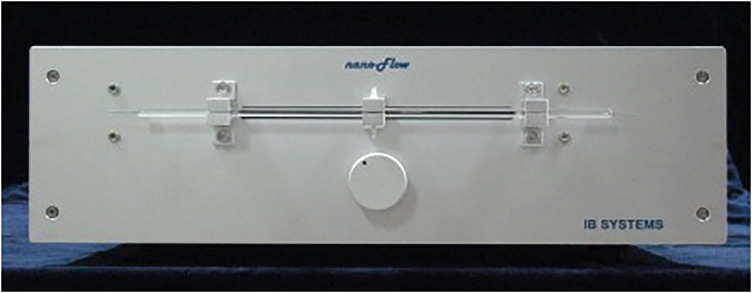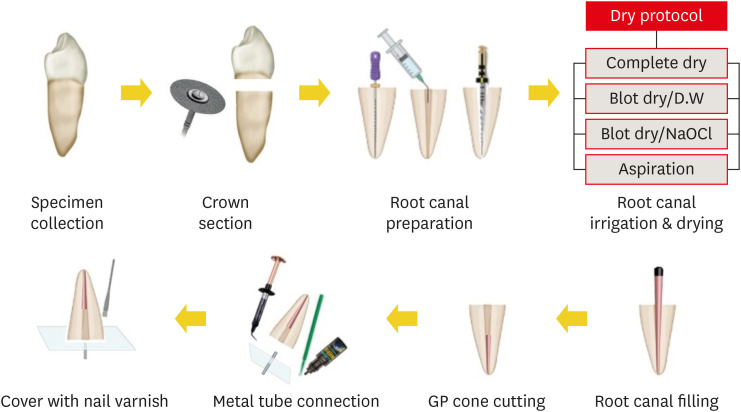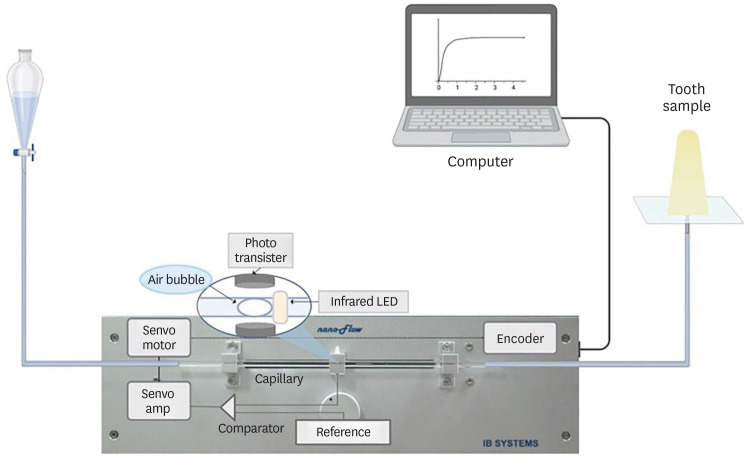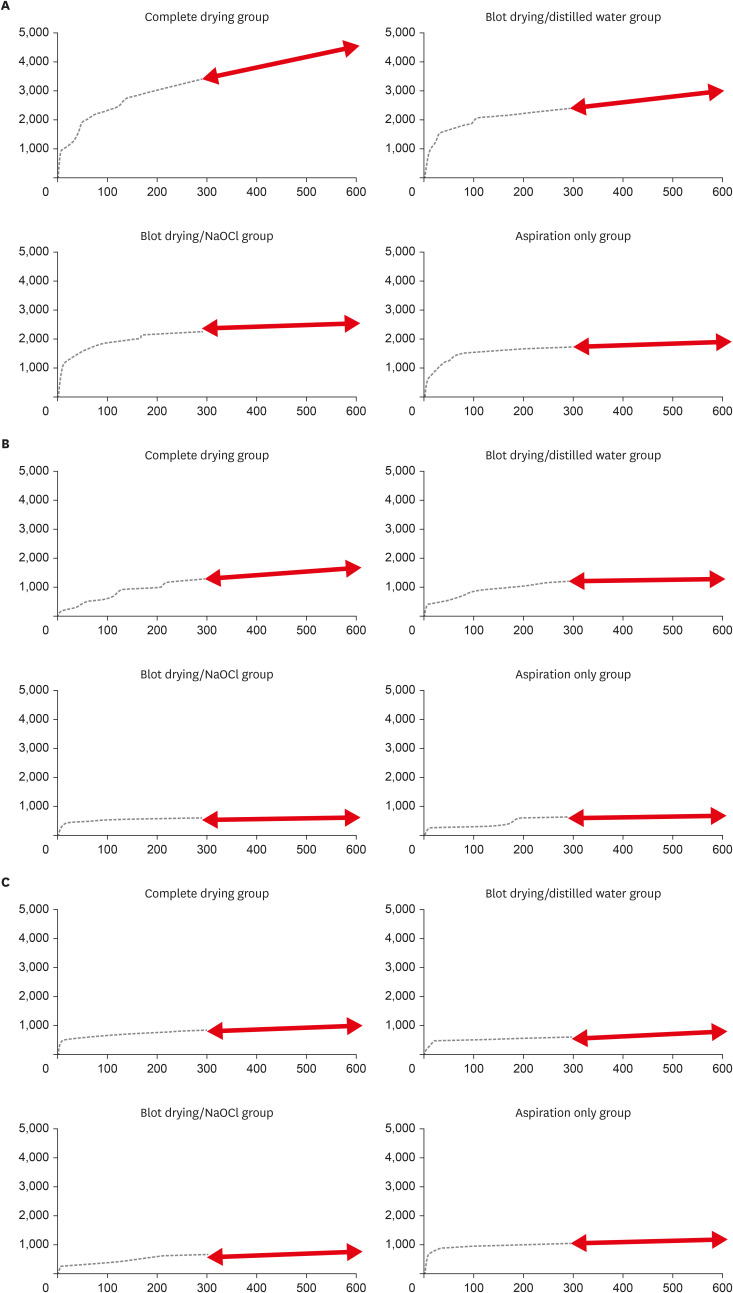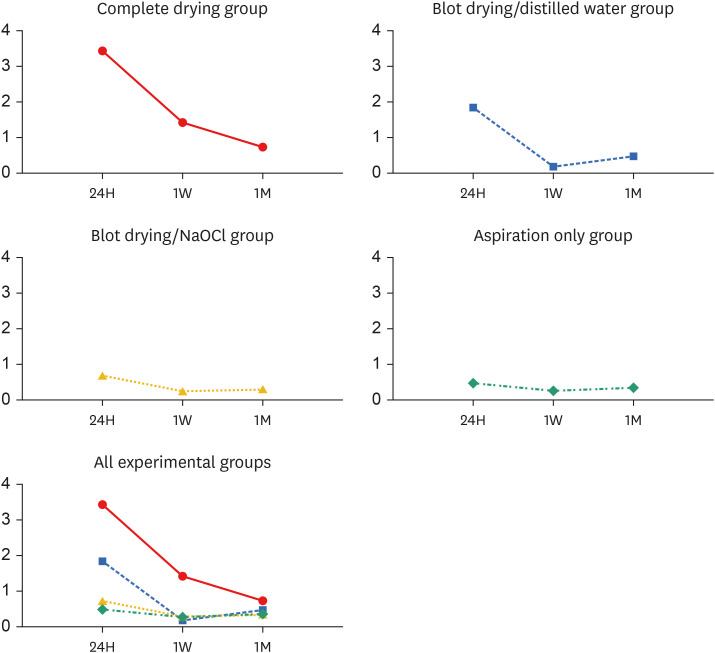Restor Dent Endod.
2024 May;49(2):e20. 10.5395/rde.2024.49.e20.
Nanoleakage of apical sealing using a calcium silicate-based sealer according to canal drying methods
- Affiliations
-
- 1Department of Conservative Dentistry, College of Dentistry, Gangneung-Wonju National University, Gangneung, Korea
- KMID: 2556549
- DOI: http://doi.org/10.5395/rde.2024.49.e20
Abstract
Objectives
This study investigated the nanoleakage of root canal obturations using calcium silicate-based sealer according to different drying methods.
Materials and Methods
Fifty-two extracted mandibular premolars with a single root canal and straight root were selected for this study. After canal preparation with a nickel-titanium rotary file system, the specimens were randomly divided into 4 groups according to canal drying methods (1: complete drying, 2: blot drying/distilled water, 3: blot drying/NaOCl, 4: aspiration only). The root canals were obturated using a single-cone filling technique with a calcium silicate–based sealer. Nanoleakage was evaluated using a nanoflow device after 24 hours, 1 week, and 1 month. Data were collected twice per second at the nanoscale and measured in nanoliters per second. Data were statistically analyzed using the Kruskal-Wallis and Mann–Whitney U-tests (p < 0.05).
Results
The mean flow rate measured after 24 hours showed the highest value among the time periods in all groups. However, the difference in the flow rate between 1 week and 1 month was not significant. The mean flow rate of the complete drying group was the highest at all time points. After 1 month, the mean flow rate in the blot drying group and the aspiration group was not significantly different.
Conclusions
Within the limitations of this study, the canal drying method had a significant effect on leakage and sealing ability in root canal obturations using a calcium silicate-based sealer. Thus, a proper drying procedure is critical in endodontic treatment.
Keyword
Figure
Reference
-
1. Hosoya N, Nomura M, Yoshikubo A, Arai T, Nakamura J, Cox CF. Effect of canal drying methods on the apical seal. J Endod. 2000; 26:292–294. PMID: 11199739.2. Ingle JI, Taintor JF. Endodontics. Philadelphia, PA: Lea & Febiger;1985.3. Tabassum S, Khan FR. Failure of endodontic treatment: the usual suspects. Eur J Dent. 2016; 10:144–147. PMID: 27011754.4. DeLong C, He J, Woodmansey KF. The effect of obturation technique on the push-out bond strength of calcium silicate sealers. J Endod. 2015; 41:385–388. PMID: 25576202.5. Grossman LI, Oliet S, Del Río CE. Endodontic practice. Philadelphia, PA: Lea & Febiger;1988.6. Zhou HM, Shen Y, Zheng W, Li L, Zheng YF, Haapasalo M. Physical properties of 5 root canal sealers. J Endod. 2013; 39:1281–1286. PMID: 24041392.7. Poggio C, Arciola CR, Dagna A, Colombo M, Bianchi S, Visai L. Solubility of root canal sealers: a comparative study. Int J Artif Organs. 2010; 33:676–681. PMID: 20963731.8. Garrido AD, Lia RC, França SC, da Silva JF, Astolfi-Filho S, Sousa-Neto MD. Laboratory evaluation of the physicochemical properties of a new root canal sealer based on Copaifera multijuga oil-resin. Int Endod J. 2010; 43:283–291. PMID: 20487447.9. Silva Almeida LH, Moraes RR, Morgental RD, Pappen FG. Are premixed calcium silicate-based endodontic sealers comparable to conventional materials? A systematic review of in vitro studies. J Endod. 2017; 43:527–535. PMID: 28216270.10. Candeiro GT, Moura-Netto C, D’Almeida-Couto RS, Azambuja-Júnior N, Marques MM, Cai S, et al. Cytotoxicity, genotoxicity and antibacterial effectiveness of a bioceramic endodontic sealer. Int Endod J. 2016; 49:858–864. PMID: 26281002.11. Troiano G, Perrone D, Dioguardi M, Buonavoglia A, Ardito F, Lo Muzio L. In vitro evaluation of the cytotoxic activity of three epoxy resin-based endodontic sealers. Dent Mater J. 2018; 37:374–378. PMID: 29593163.12. Jung S, Sielker S, Hanisch MR, Libricht V, Schäfer E, Dammaschke T. Cytotoxic effects of four different root canal sealers on human osteoblasts. PLoS One. 2018; 13:e0194467. PMID: 29579090.13. Cardoso IV, Seixas-Silva ML, Rover G, Bortoluzzi EA, da Fonseca Roberti Garcia L, Teixeira CS. Influence of different root canal drying protocols on the bond strength of a bioceramic endodontic sealer. G Ital Endod. 2021; 36:151–161.14. Abu Zeid ST, Alnoury A. Characterisation of the bioactivity and the solubility of a new root canal sealer. Int Dent J. 2023; 73:760–769. PMID: 37244780.15. Zordan-Bronzel CL, Esteves Torres FF, Tanomaru-Filho M, Chávez-Andrade GM, Bosso-Martelo R, Guerreiro-Tanomaru JM. Evaluation of physicochemical properties of a new calcium silicate-based sealer, Bio-C Sealer. J Endod. 2019; 45:1248–1252. PMID: 31447172.16. Souza LC, Neves GS, Kirkpatrick T, Letra A, Silva R. Physicochemical and biological properties of AH Plus Bioceramic. J Endod. 2023; 49:69–76. PMID: 36279961.17. Rekha R, Kavitha R, Venkitachalam R, Prabath SV, Deepthy S, Krishnan V. Comparison of the sealing ability of bioceramic sealer against epoxy resin based sealer: a systematic review & meta-analysis. J Oral Biol Craniofac Res. 2023; 13:28–35. PMID: 36345495.18. Donnermeyer D, Bürklein S, Dammaschke T, Schäfer E. Endodontic sealers based on calcium silicates: a systematic review. Odontology. 2019; 107:421–436. PMID: 30554288.19. Wang JS, Bai W, Wang Y, Liang YH. Effect of different dentin moisture on the push-out strength of bioceramic root canal sealer. J Dent Sci. 2023; 18:129–134. PMID: 36643254.20. Ozlek E, Gündüz H, Akkol E, Neelakantan P. Dentin moisture conditions strongly influence its interactions with bioactive root canal sealers. Restor Dent Endod. 2020; 45:e24. PMID: 32483541.21. Al-Haddad AY, Kutty MG, Abu Kasim NH, Che Ab Aziz ZA. The effect of moisture conditions on the constitution of two bioceramic-based root canal sealers. J Dent Sci. 2017; 12:340–346. PMID: 30895073.22. Paula AC, Brito-Júnior M, Araújo CC, Sousa-Neto MD, Cruz-Filho AM. Drying protocol influence on the bond strength and apical sealing of three different endodontic sealers. Braz Oral Res. 2016; 30:S1806-83242016000100248.23. Razmi H, Bolhari B, Karamzadeh Dashti N, Fazlyab M. The effect of canal dryness on bond strength of bioceramic and epoxy-resin sealers after irrigation with sodium hypochlorite or chlorhexidine. Iran Endod J. 2016; 11:129–133. PMID: 27141222.24. Khurana N, Chourasia HR, Singh G, Mansoori K, Nigam AS, Jangra B. Effect of drying protocols on the bond strength of bioceramic, MTA and resin-based sealer obturated teeth. Int J Clin Pediatr Dent. 2019; 12:33–36. PMID: 31496569.25. Starkey DL, Anderson RW, Pashley DH. An evaluation of the effect of methylene blue dye pH on apical leakage. J Endod. 1993; 19:435–439. PMID: 8263449.26. Wimonchit S, Timpawat S, Vongsavan N. A comparison of techniques for assessment of coronal dye leakage. J Endod. 2002; 28:1–4. PMID: 11806641.27. Tselnik M, Baumgartner JC, Marshall JG. Bacterial leakage with mineral trioxide aggregate or a resin-modified glass ionomer used as a coronal barrier. J Endod. 2004; 30:782–784. PMID: 15505510.28. Benner MD, Peters DD, Grower M, Bernier WE. Evaluation of a new thermoplastic gutta-percha obturation technique using 45Ca. J Endod. 1981; 7:500–508. PMID: 7028909.29. Czonstkowsky M, Michanowicz A, Vazquez JA. Evaluation of an injection of thermoplasticized low-temperature gutta-percha using radioactive isotopes. J Endod. 1985; 11:71–74. PMID: 3882876.30. Güneş B, Aydınbelge HA. Assessment of the sealing ability of resin based root-canal sealers using glucose leakage model. Selcuk Dent J. 2017; 4:116–122.31. Hwang HK, Park SH, Lee YJ. Comparative study on the apical sealing ability according to the obturation techniques. J Korean Acad Conserv Dent. 2002; 27:290–298.32. Asawaworarit W, Pinyosopon T, Kijsamanmith K. Comparison of apical sealing ability of bioceramic sealer and epoxy resin-based sealer using the fluid filtration technique and scanning electron microscopy. J Dent Sci. 2020; 15:186–192. PMID: 32595900.33. Lee IB, Kim MH, Kim SY, Chang JH, Cho BH, Son HH, et al. Development of nano-fluid movement measuring device and its application to hydrodynamic analysis of dentinal fluid. J Korean Acad Conserv Dent. 2008; 33:141–147.34. Oruçoğlu H, Sengun A, Yilmaz N. Apical leakage of resin based root canal sealers with a new computerized fluid filtration meter. J Endod. 2005; 31:886–890. PMID: 16306824.35. Pashley DH, Matthews WG, Zhang Y, Johnson M. Fluid shifts across human dentine in vitro in response to hydrodynamic stimuli. Arch Oral Biol. 1996; 41:1065–1072. PMID: 9068870.36. Kolker JL, Vargas MA, Armstrong SR, Dawson DV. Effect of desensitizing agents on dentin permeability and dentin tubule occlusion. J Adhes Dent. 2002; 4:211–221. PMID: 12666757.37. Ratih DN, Palamara JE, Messer HH. Dentinal fluid flow and cuspal displacement in response to resin composite restorative procedures. Dent Mater. 2007; 23:1405–1411. PMID: 17296218.38. Moraes TG, Menezes AS, Grazziotin-Soares R, Moraes RU, Ferreira PV, Carvalho CN, et al. Impact of immersion media on physical properties and bioactivity of epoxy resin-based and bioceramic endodontic sealers. Polymers (Basel). 2022; 14:729. PMID: 35215641.39. Urban K, Neuhaus J, Donnermeyer D, Schäfer E, Dammaschke T. Solubility and pH value of 3 different root canal sealers: a long-term investigation. J Endod. 2018; 44:1736–1740. PMID: 30243663.40. Neelakantan P, Subbarao C, Subbarao CV, De-Deus G, Zehnder M. The impact of root dentine conditioning on sealing ability and push-out bond strength of an epoxy resin root canal sealer. Int Endod J. 2011; 44:491–498. PMID: 21255047.
- Full Text Links
- Actions
-
Cited
- CITED
-
- Close
- Share
- Similar articles
-
- Comparison of sealing ability of different obturation techniques in type II root canals
- Calcium silicate-based root canal sealers: a literature review
- Micro-computed tomographic evaluation of a new system for root canal filling using calcium silicatebased root canal sealers
- Effect of moisture on sealing ability of root canal filling with different types of sealer through the glucose penetration model
- Efficacy of retreatment NiTi files for root canals filled with calcium silicate-based sealer

